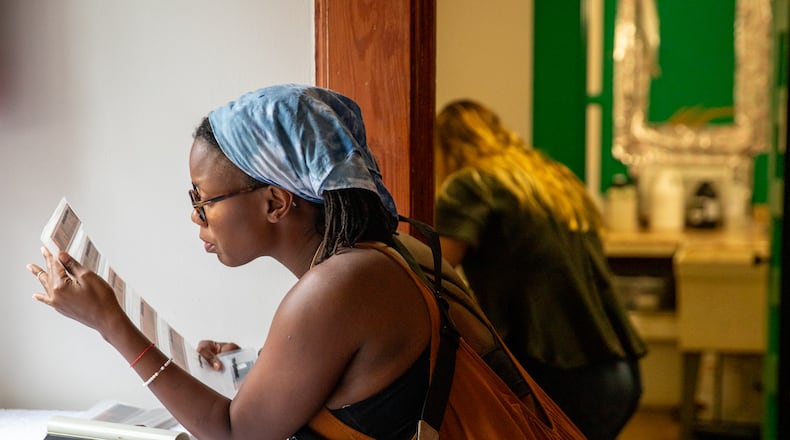One muggy Thursday evening in June, students of various ages filed into the Callanwolde Fine Arts Center darkroom to turn their negatives into prints. Beneath the watchful eye of instructor Marcus Durham, the students used chemicals rather than code to create the perfect image.
People with all sorts of backgrounds sign up for the class, said Durham. Some worked with film when they were young and are hoping to get back into it, while others came into possession of a film camera and are practicing the art for the first time.
Lauren Jones is one student who falls into the latter category. She inherited her film camera from her grandfather, who died about four years ago. On that Thursday evening, she developed some of his old negatives she found in her attic.
“Photographing the family and what we were doing was so important to him,” Jones said. “It’s quite easy to relive these things that I don’t quite remember, for various reasons, when he’s not around.”
Working with film allows her to slow down, she said, to be “thoughtful” and “meditative about a thing.”
Jones isn’t alone. Film photography’s mainstream appeal has grown in recent years, prompting film shortages, a spike in film prices and the opening of new film labs. Gen Zers and millennials in particular find themselves drawn to the aesthetic and are trading their DSLRs for disposable cameras and Photoshop for Fujifilm.
Slowing down, staying present
Jones’ favorite part of the developing process is the moment when the image starts to appear. The blank photo paper slides into the developer bath and seconds later, shades and shadows take shape.
Developing photos allows her to indulge in the process instead of rushing through it.
Ashton Melton, a 22-year-old rising senior at Savannah College of Art and Design, discovered film photography when she was in high school. She finds it rewarding to know she’s continuing a practice with so much history.
“It was me reclaiming an old process and being able to put my own spin on it in regards to what I was photographing,” she said. “It makes you really slow down and capture moments that you think are really impactful because you only have 36 frames to shoot.”
Aesthetically, Melton said the new crop of film photographers are seeking a style that isn’t modern — to capture a feeling of timelessness. Jones agreed, noting that some people buy digital cameras that produce photos with a film effect.
But Jones, 37, also suspects the appeal of film photography is its ability to make younger folks feel like they can “reclaim time.”
“I think we are all feeling like we’re moving so fast, and I think it’s maybe these types of mediums that help you, I don’t know, just go back a little bit,” she said.
Credit: Jenni Girtman
Credit: Jenni Girtman
With only 36 exposures on a roll of film, making mistakes is expensive, and it could mean losing a moment forever. Jones knows this feeling all too well. After her first time taking photos with a film camera, she discovered that the whole roll came out blank.
With film, you don’t get the luxury of deleting or retaking an unsuccessful photo, Durham said. He pointed out the image of the Marines raising a flag at Iwo Jima by Joe Rosenthal, or the photo “Afghan Girl” by Steve McCurry of a refugee with piercing eyes — these were accidents, he said. They were moments a photographer might not have realized they captured until hours later, after the darkroom revealed a photo that eventually “made it into our cultural consciousness,” he said.
“I think that is where film excels,” Durham said. “Because it requires a photographer to be present in everything that’s going on around them.”
Credit: Jenni Girtman
Credit: Jenni Girtman
A growing industry
A renewed interest in film photography is having a big effect on an industry that was looking obsolete a decade ago.
In 2004, major film producer Kodak announced it would stop production and sale of its traditional 35mm film camera in North America. As the newest digital technology began filling store shelves, its older counterpart started to disappear. Even now, there are only a few new film cameras in production, and they carry a hefty price tag.
But since Kodak filed for Chapter 11 bankruptcy in 2012, the company has experienced something of a revival in the years following. Last fall, Kodak announced on Twitter that it had hired more than 300 people and would be hiring even more to keep up with demand for 35mm film.
Mike Morrison, who’s been working at family-owned camera shop Wings Camera & Digital on Briarcliff Road for more than 40 years, knew film would always stick around, but he didn’t expect such a dramatic comeback.
“I would say in the past five years ... film is starting to become the rage again,” Morrison said. “We didn’t know it was gonna happen this big.”
The store sells about 100 rolls of film a week and receives 50 to 60 rolls a week to process. Five years ago, it was about half that. Now, they’re having trouble keeping enough film in stock, and Morrison estimates the cost of film has gone up by about 15% this year.
Jones notes it is an expensive hobby and there are few darkrooms available for rent in Atlanta. Hoping to help fill that void is Bellows Film Lab which opened in June. The Little Five Points location looks like a trendy grocery store with bright colors and neon lights, but the refrigerator in the back is cleverly supplied with film of various stocks. Customers can drop off their film to be developed onsite, or they can rent the darkroom themselves for $20 an hour.
Owner Marcello Peschiera, who also has locations in Miami and Chicago, said he wants to make film photography more accessible for people. It’s an idea that resonates. On opening day, Peschiera said around 500 people visited.
He wants his stores to be a spot where people can ask questions and learn about film photography without feeling intimidated.
“I’ve learned almost everything about photography from other people,” he said.
A tangible medium
There was a time when families owned stacks of photo albums filled with pictures of family vacations, birthday parties and other special occasions. Now all our photos live online.
Jones has two kids with a third on the way. As she considers what she’ll leave behind as a parent, she’s come to recognize that tangible photos are precious objects worth saving.
Her children’s lives have been well documented on Facebook, but she rarely has a reason to scroll through it. Jones wants her children to have physical images, like when she goes to her aunt’s house and can “touch and feel” the photo albums filled with pictures of her younger self.
While Jones reserves the film camera for special occasions, her grandfather took photos of anything and everything. Through some of the pictures he left behind, old memories have resurfaced and new information gleaned. From a photograph she was able to ascertain the missing ingredient in the tea cakes they made together (evaporated milk). They even located her great grandparents’ gravesites using a photo he had taken of her in front of it.
“If I have access to a darkroom, I can have those memories myself,” she said.
About the Author
Keep Reading
The Latest
Featured






